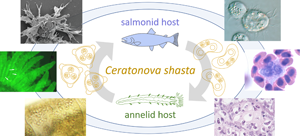Published online by Cambridge University Press: 09 September 2022

The myxozoan Ceratonova shasta was described from hatchery rainbow trout over 70 years ago. The parasite continues to cause severe disease in salmon and trout, and is recognized as a barrier to salmon recovery in some rivers. This review incorporates changes in our knowledge of the parasite's life cycle, taxonomy and biology and examines how this information has expanded our understanding of the interactions between C. shasta and its salmonid and annelid hosts, and how overarching environmental factors affect this host–parasite system. Development of molecular diagnostic techniques has allowed discrimination of differences in parasite genotypes, which have differing host affinities, and enabled the measurement of the spatio-temporal abundance of these different genotypes. Establishment of the C. shasta life cycle in the laboratory has enabled studies on host–parasite interactions and the availability of transcriptomic data has informed our understanding of parasite virulence factors and host defences. Together, these advances have informed the development of models and management actions to mitigate disease.